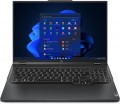Model
The specific model of the processor installed in the laptop, or rather, the processor index within its series (see above). Knowing the full name of the processor (series and model), you can find detailed information on it (up to practical reviews) and clarify its capabilities.
Code name
The code name for CPU installed in the laptop.
This parameter characterizes, first of all, the generation to which the processor belongs, and the microarchitecture used in it. At the same time, chips with different code names can belong to the same microarchitecture/generation; in such cases, they differ in other parameters - general positioning, belonging to certain series (see above), the presence / absence of certain specific functions, etc.
Nowadays, the following code names are relevant in Intel processors:
Coffee Lake,
Comet Lake,
Ice Lake,
Tiger Lake,
Jasper Lake,
Alder Lake,
Raptor Lake (13th Gen),
Alder Lake-N,
Raptor Lake (14th Gen),
Meteor Lake (Series 1),
Raptor Lake (Series 1),
Lunar Lake (Series 2).
For AMD, the list looks like this:
Zen 2 Renoir,
Zen 2 Lucienne,
Zen 3 Cezanne,
Zen 3 Barcelo,
Zen 3+ Rembrandt,
Zen 3+ Rembrandt R,
Zen 2 Mendocino,
Zen 3 Barcelo R,
Zen 4 Dragon Range,
Zen 4 Phoenix
Zen 4 Hawk Point,
Zen 5 Strix Point.
Detailed data on different code names can be found in special sources.
CPU speed
The clock speed of the processor installed in the laptop (for multi-core processors, the frequency of each individual core).
Theoretically, a higher clock speed has a positive effect on performance, as it allows the processor to perform more operations per unit of time. However, in fact, the capabilities of the CPU depend on a number of other characteristics — primarily on the series to which it belongs (see above). It even happens that of the two chips, the more performant in the overall result is the slower one. With this in mind, it makes sense to compare by clock frequency only processors of the same series, and ideally, also of the same generation; and the laptop as a whole should be judged by the complex characteristics of the system, as well as by the results of tests (see below).
CPU TDP
The amount of heat generated by the processor during normal operation. This parameter determines the requirements for the cooling system necessary for the normal operation of the processor, therefore it is sometimes called TDP - thermal design power, literally “thermal (cooling) system power”. Simply put, if the processor has a heat dissipation of 60 W, it needs a cooling system that can remove at least this amount of heat. Accordingly, the lower the TDP, the lower the requirements for the cooling system.
3DMark06
The result shown by the laptop processor in 3DMark06.
This test is primarily focused on testing performance in games — in particular, the ability of the processor to process advanced graphics and artificial intelligence elements. Test scores are reported as scores; the higher this number, the higher the performance of the tested chip. Good 3DMark06 results are especially important for
gaming laptops.
Passmark CPU Mark
The result shown by the laptop processor in the Passmark CPU Mark test.
Passmark CPU Mark is a comprehensive test that is more detailed and reliable than the popular 3DMark06 (see above). It checks not only the gaming capabilities of the CPU, but also its performance in other modes, based on which it displays the overall score; this score can be used to fairly reliably evaluate the processor as a whole (the more points, the higher the performance).
RAM speed
The clock speed of the RAM installed in the laptop.
The higher the frequency (with the same type and amount of memory) — the higher the performance of RAM in general and the faster the laptop will cope with resource-intensive tasks. However modules with the same frequency may differ somewhat in actual performance due to differences in other characteristics; but this difference becomes significant only in very specific cases, for the average user it is not critical. As for specific values, the most popular modules on the modern market are
2400 MHz,
2666 MHz,
2933 MHz and
3200 MHz. Memory at
2133 MHz or less is found mainly in outdated and low-cost devices, and in high-performance configurations this parameter is
2933 MHz,
3200 MHz,
4266 MHz,
4800 MHz,
5200 MHz,
5500 MHz,
5600 MHz and
more.
3DMark06
The result shown by the laptop's graphics card in 3DMark06.
This test primarily determines how well a graphics card handles intensive workloads, in particular, with detailed 3D graphics. The test result is indicated in points; the more points, the higher the performance of the video adapter. Good 3DMark06 scores are especially important for
gaming laptops and advanced workstations. However, it is difficult to call them reliable, since measurements are made on video cards with different TDPs and an overall average score is given. Thus, your laptop can have either more or less than the specified result - it all depends on the TDP of the installed video card.
M.2 connector interface
The interface of the main M.2 connector provided in the laptop.
In this case, the main slot is considered to be the one in which the SSD M.2 drive is installed (see "Drive type"). The interface of the drive itself is indicated separately (see above), and the interface of the connector is specified if the connector supports a more advanced type of connection than the device installed in it. An example is the following situation: the device itself works according to the SATA or PCI-E 3.0 2x standard (see "M.2 drive interface" above), and the connector on the board is capable of working with the PCI-E 3.0 4x interface.
Such information will be useful, first of all, for evaluating the possibilities for upgrading a laptop (with replacing a standard SSD module with a faster one). Nowadays, in this paragraph, you can mainly find the following options:
— PCI-E 3.0 2x. In fact, the most modest PCI-E standard found in M.2 ports of modern laptops: connection using 2 lanes of PCI-E version 3.0. This version provides speeds of about 1 GB/s per line; respectively, two lines give a maximum of just under 2 GB / s.
— PCI-E 3.0 4x. Connection using 4 lanes PCI-E version 3.0. Provides a maximum speed of about 4 GB / s.
— PCI-E 4.0 4x. Connection using 4 lanes PCI-E version 4.0. In this version, the bandwidth, compared to PCI-E 3.0, has been doubled — thus, 4 lines give a maximum speed of about 8 GB / s.
— PCI-E. Connection...via PCI-E, for which the manufacturer did not specify the details (version and number of lines).
Recall that in the case of M.2 connectors, different PCI-E options are quite compatible with each other — except that the speed will be limited by the capabilities of a slower component. In fact, this means that, for example, in an M.2 connector with a PCI-E 3.0 4x interface, it is quite possible to connect a drive for PCI-E 3.0 2x or PCI-E 4.0 4x; in the first case, the speed will be limited by the capabilities of the drive, in the second, by the capabilities of the connector.

